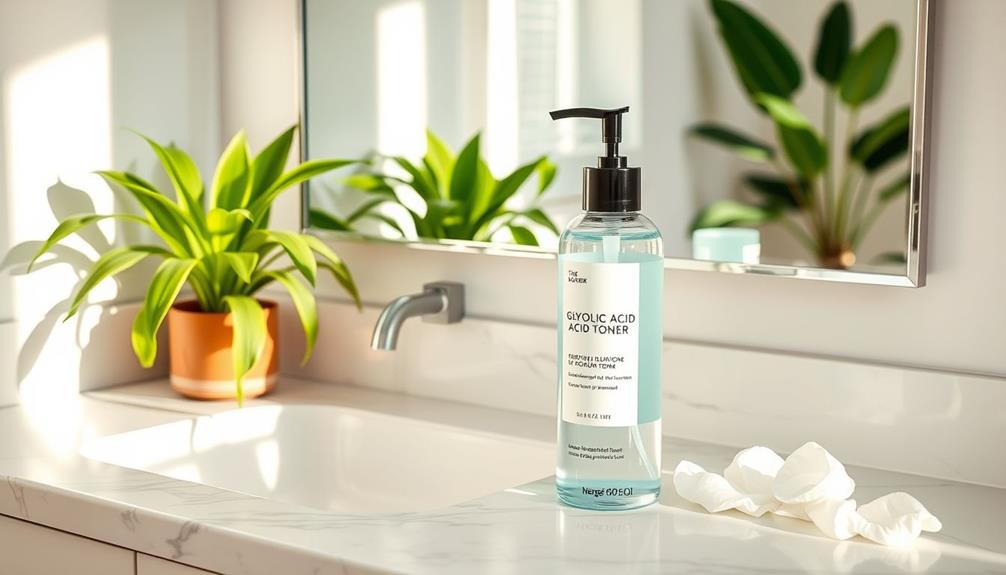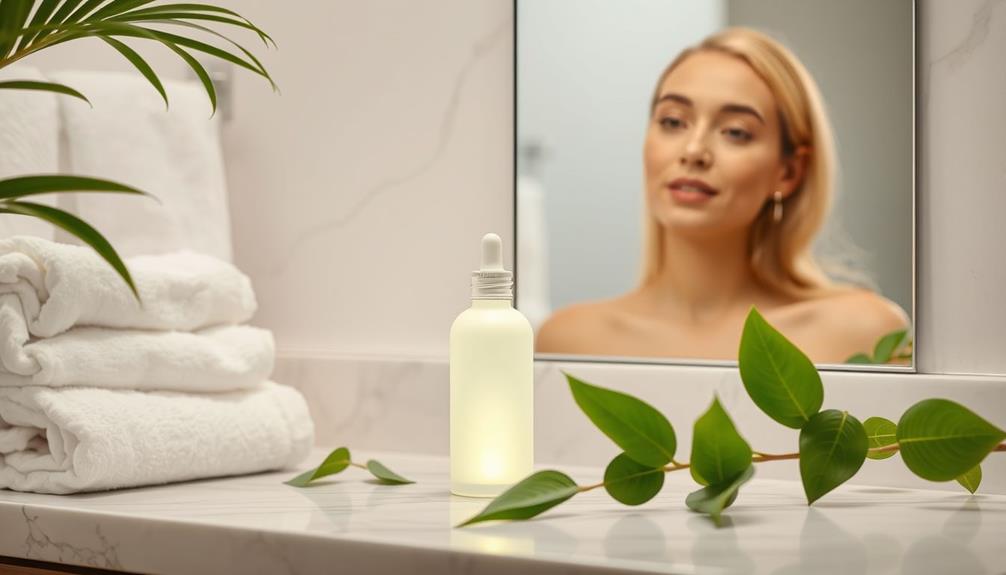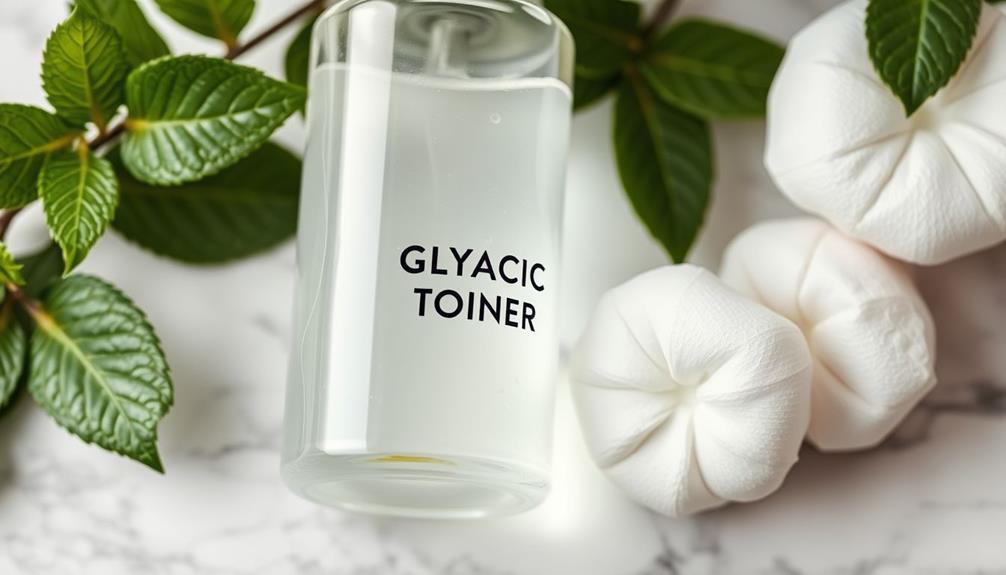If you have acne-prone skin, using a glycolic acid toner may be the perfect solution for you. This alpha-hydroxy acid helps to unclog pores, reduce inflammation, and improve your skin’s texture. Regular use can increase cell turnover, resulting in clearer skin and a reduction in post-acne scars. It is recommended to start with a toner that has a 5-10% concentration, applying it daily while monitoring how your skin responds. Don’t forget to follow up with a moisturizer to keep your skin hydrated. Choosing the right product is crucial for achieving the best results. Stay tuned to discover recommended toners and tips to enhance your skincare routine!
Key Takeaways
- Glycolic acid toner exfoliates dead skin cells, promoting cell turnover and preventing clogged pores, reducing acne breakouts effectively.
- It possesses anti-inflammatory properties, minimizing redness and enhancing overall skin clarity and health.
- Regular use improves skin texture, leading to a smoother complexion and fading post-acne scars and hyperpigmentation.
- Suitable concentrations range from 5% to 10%; start with lower concentrations to monitor skin sensitivity.
Glycolic Acid Explained

Glycolic acid, a powerful alpha-hydroxy acid derived from sugar cane, effectively exfoliates your skin by removing dead cells and promoting cell turnover. This small-molecule acid penetrates deeply, making it particularly effective in addressing concerns like uneven skin texture and dullness.
If you're struggling with acne or its aftermath, incorporating glycolic acid into your routine can be a game changer. Additionally, using vital oils in conjunction with glycolic acid can enhance your skincare routine by providing stress relief benefits and soothing skin irritation.
When you apply glycolic acid, it works by breaking down the bonds between dead skin cells, allowing them to slough off more easily. This exfoliating action not only helps clear clogged pores but also reveals fresher, healthier skin underneath. With regular use, you might notice a smoother texture and a reduction in the visibility of acne scars.
Glycolic acid is commonly found in concentrations ranging from 5% to 10% in over-the-counter products, while dermatological peels can offer even higher concentrations for a more intensive treatment.
However, it's crucial to use glycolic acid carefully, as its pH level of around 3.6 can lead to irritation if overused. By incorporating this powerhouse ingredient, you can work towards achieving clearer, more radiant skin.
Benefits for Acne-Prone Skin

When you use glycolic acid toner, you'll notice its powerful exfoliating effects that help unclog pores and reduce acne breakouts.
Additionally, incorporating essential oils for skin can complement your skincare routine by providing antimicrobial properties and enhancing overall wellness.
It also works to minimize inflammation and redness, giving your skin a clearer and calmer appearance.
Plus, regular use can enhance your skin's texture, making it smoother and more radiant over time.
Exfoliation and Unclogging Pores
Exfoliating with an effective toner can greatly help unclog pores and reduce acne breakouts. A glycolic acid toner is particularly beneficial because it contains alpha-hydroxy acids (AHAs) that dissolve the bonds between dead skin cells.
By promoting the shedding of these cells, it prevents clogged pores, which are a major contributor to acne. Incorporating a consistent skincare routine, similar to how gentle yoga stretches can alleviate back pain, is key in achieving clear skin.
You'll notice that regular exfoliation not only reduces the formation of acne and blackheads but also enhances your overall skin texture.
As you incorporate glycolic acid toner into your skincare routine, you're also addressing post-acne scars and hyperpigmentation.
This toner helps even out your skin tone while stimulating collagen production, which can thicken the skin and minimize the appearance of fine lines.
With consistent use, you'll achieve a clearer complexion and a smoother texture.
Moreover, using a glycolic acid toner can enhance the effectiveness of other acne treatments.
It allows for better penetration of topical medications, leading to more visible results.
Reducing Inflammation and Redness
Incorporating a glycolic acid toner not only helps with unclogging pores but also effectively reduces inflammation and redness associated with acne-prone skin.
Glycolic acid, an alpha-hydroxy acid (AHA), works by promoting exfoliation, which removes dead skin cells that can contribute to breakouts. This process not only combats acne-causing bacteria but also minimizes the chances of further inflammation.
To enhance your skincare routine further, consider integrating gentle yoga stretches before bedtime, as they can help reduce stress and promote overall skin health gentle yoga stretches.
Regular use of a glycolic acid toner can greatly improve your skin's overall condition. It aids in reducing redness, giving you a more even complexion.
By stimulating collagen production, glycolic acid strengthens your skin barrier, making it less sensitive and more resilient over time. You'll notice a decrease in the severity of acne lesions, leading to less visible inflammation.
As you integrate glycolic acid into your skincare routine, you'll find that it doesn't just focus on immediate results; it also enhances your skin's long-term health.
Over time, you can expect a smoother skin texture and a reduction in the persistent redness that often accompanies acne-prone skin.
Embrace glycolic acid as a key ally in your journey toward clearer, calmer skin.
Enhancing Skin Texture Improvement
Glycolic acid toners offer a powerful solution for enhancing skin texture, helping you achieve a smoother and more radiant complexion. By using glycolic acid, you effectively exfoliate the skin, dissolving the bonds between dead skin cells. This process not only unclogs pores but also greatly reduces the occurrence of acne breakouts.
With a 7% concentration, glycolic acid works wonders to improve skin texture, smoothing rough patches and boosting overall radiance. Additionally, regular playtime is important for mental and physical stimulation in pets, just as maintaining a consistent skincare routine is essential for your skin's health understanding a cat's body language.
Regularly incorporating glycolic acid into your skincare routine can help fade post-acne scars and hyperpigmentation, promoting a more even skin tone. You'll notice a transformation as your skin becomes clearer and healthier.
Additionally, the antibacterial properties of glycolic acid help calm existing acne lesions, reducing inflammation that can worsen your skin's texture.
Moreover, glycolic acid toners enhance moisture retention in your skin barrier, counteracting the dryness often associated with acne treatments. This leads to a balanced, hydrated complexion that feels revitalized.
Recommended Glycolic Acid Toners

Finding the right glycolic acid toner can dramatically improve your skincare routine, especially if you have acne-prone skin. These toners not only help with gentle exfoliation but also target skin discoloration and texture.
For those looking for effective skincare solutions, water parks in Washington DC can offer unique experiences that promote wellness and relaxation.
Here are some top recommendations:
- The Ordinary Glycolic Acid 7% Toning Solution: Highly rated at 4.3/5 stars, it's great for effective exfoliation and improving skin texture, all for just $13.
- Good Molecules Glycolic Exfoliating Toner: Priced at $14 and rated 4.6/5 stars, this formula combines glycolic acid with hydrating hyaluronic acid and aloe for gentle exfoliation.
- Pixi Glow Tonic: With 5% glycolic acid, this alcohol-free toner is rated 4.7/5 stars and helps brighten your skin while reducing inflammation, priced at $27.
- SkinCeuticals Conditioning Clarifying Toner: Targeting both acne and pore congestion, this toner combines glycolic and salicylic acids and is rated 4.7/5 stars at $38.
These options can help you achieve clearer, healthier skin.
How to Use Glycolic Acid
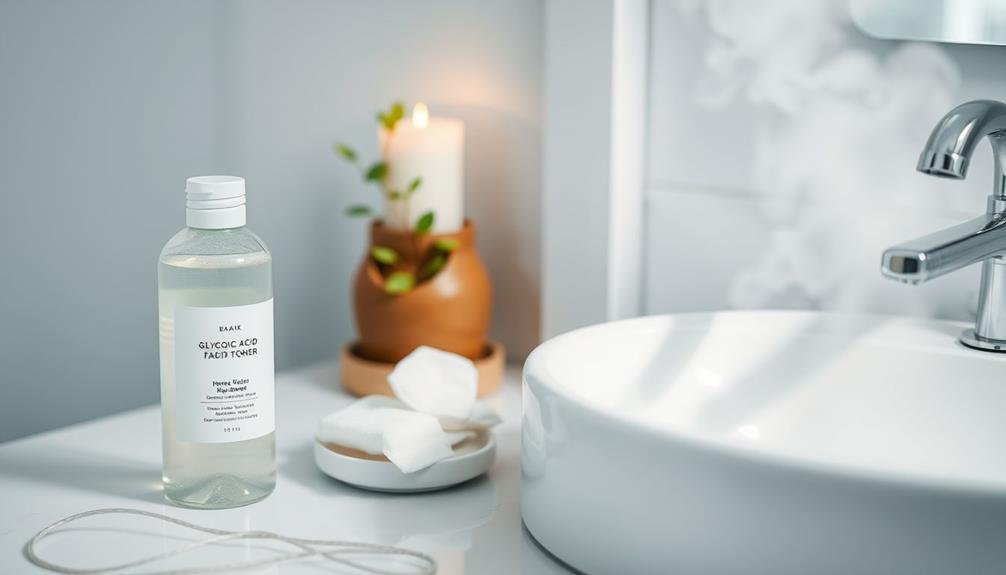
Using a glycolic acid toner can greatly enhance your skincare routine when applied correctly.
Begin by choosing a toner that contains a low concentration of glycolic acid, around 5-7%. This helps minimize irritation as your skin adjusts. Before diving in, it's wise to perform a patch test to verify your skin tolerates the product.
Apply the toner using a cotton pad, sweeping it evenly over your cleansed skin. Avoid the eye area and any broken skin to prevent irritation.
For the best results, use the toner in the evening as part of your nighttime routine. This allows glycolic acid to exfoliate dead skin cells while you sleep.
After application, always follow up with a hydrating moisturizer to soothe your skin and lock in moisture.
Who Should Avoid It

If you have sensitive skin, active skin conditions like eczema or rosacea, or have recently sunburned, glycolic acid toner mightn't be right for you.
The irritation it can cause isn't worth the risk of flare-ups or discomfort.
Always listen to your skin and consider alternatives if you notice any adverse reactions.
Sensitive Skin Types
Avoiding glycolic acid toners is essential for individuals with sensitive skin, as they may face increased irritation and discomfort from the product's exfoliating properties. If you have sensitive skin, you should be cautious when considering glycolic acid in your skin care routine.
Here are some key points to keep in mind:
- People can use glycolic acid every so often, but it's important to assess your skin's tolerance first.
- Patch testing is critical; always conduct a small test before applying it to your entire face.
- Overuse can lead to skin barrier damage, leaving your skin vulnerable and irritated.
- If you have conditions like eczema or rosacea, glycolic acid may exacerbate your sensitivity.
For those with sensitive skin, it's best to explore gentler alternatives that won't compromise your skin's health or comfort.
Always prioritize your skin's well-being over the latest trends in skin care.
Active Skin Conditions
Individuals with active skin conditions, such as eczema or rosacea, should steer clear of glycolic acid toners due to the heightened risk of irritation and flare-ups.
If you have dry or sensitive skin, using glycolic acid might lead to adverse reactions like swelling, itching, or burning. These reactions can exacerbate your skin issues instead of helping them.
Moreover, those dealing with active acne should also be cautious. While glycolic acid can improve skin texture, inconsistent or excessive use can compromise your skin barrier, worsening your condition. This is particularly true if your skin is already irritated or inflamed.
Additionally, if you have darker skin tones, be mindful of the potential for post-inflammatory hyperpigmentation that may result from irritation linked to glycolic acid.
If you're currently experiencing any active skin conditions, it's best to consult a dermatologist before incorporating glycolic acid into your routine.
Prioritizing your skin's health means knowing when to avoid certain ingredients, ensuring you don't inadvertently worsen your skin issues. Always listen to your skin and adapt your skincare routine accordingly.
Sunburn or Irritation
Glycolic acid toners should be skipped when you have sunburn, as they can intensify irritation and sensitivity in already compromised skin. If your skin is feeling sensitive due to sun exposure, using glycolic acid can worsen your discomfort. It's essential to prioritize healing before introducing any active ingredients.
You should also avoid glycolic acid toners if you're experiencing any of the following:
- Active sunburn that compromises your skin barrier
- Irritation or redness from other skincare products
- Pre-existing skin conditions like eczema or rosacea
- Peeling skin due to sun damage
Consulting a dermatologist is a smart move if you're unsure whether glycolic acid is right for you, especially if your skin is sensitive or already irritated. Taking care of your skin barrier should be your top priority during recovery.
Once your skin heals, you can consider incorporating glycolic acid toners into your routine for acne-prone skin, but only once you're confident your skin can handle it.
Importance of Exfoliation
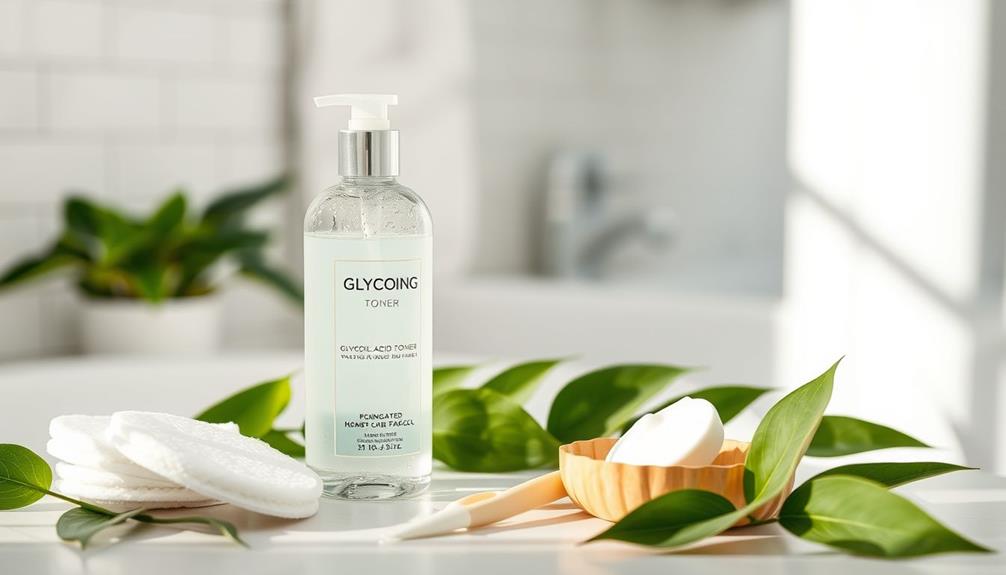
Exfoliation plays an essential role in managing acne-prone skin by clearing away dead skin cells that can clog pores and trigger breakouts. When you incorporate glycolic acid into your routine, you're enhancing your skin's natural exfoliation process. This powerful ingredient promotes cell turnover, meaning your skin renews itself more efficiently.
As a result, you'll notice improved skin texture that feels smoother and looks clearer. Regular exfoliation with glycolic acid can also help fade acne scars and reduce hyperpigmentation over time. By sloughing off those dull, dead cells, you allow fresh, healthy skin to emerge, which can greatly diminish the appearance of blemishes and dark spots.
Aim to exfoliate once or twice a week, as this will enhance the effectiveness of other topical treatments you're using, allowing them to penetrate deeper into the skin. However, be cautious not to over-exfoliate, as this can lead to irritation and compromise your skin barrier, ultimately worsening acne and sensitivity.
Finding the right balance is key to reaping the full benefits of exfoliation while maintaining healthy skin.
Expert Insights and Recommendations
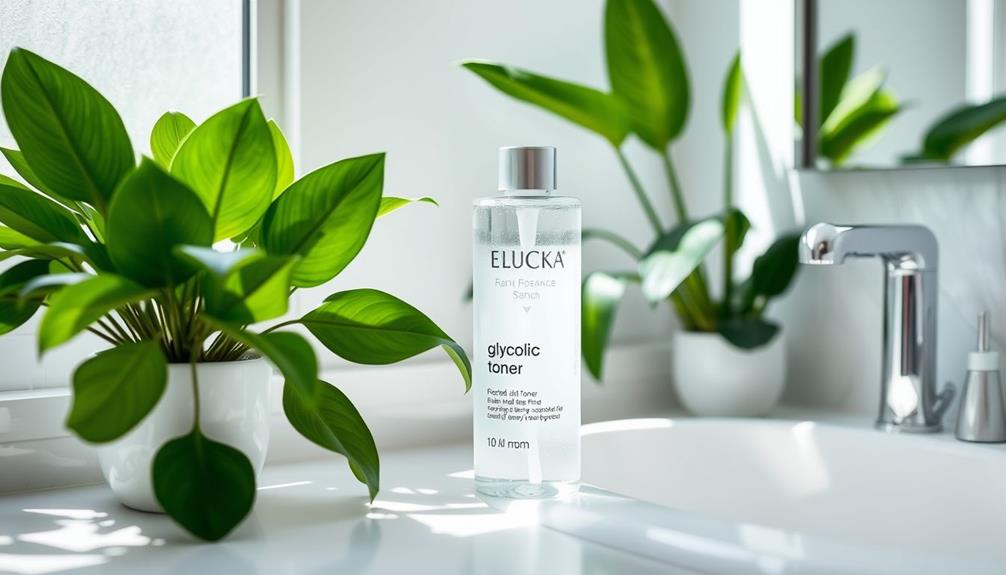
Experts strongly recommend incorporating a glycolic acid toner into your skincare routine to effectively manage acne-prone skin and enhance your overall complexion.
This powerful product helps improve skin texture and clarity by exfoliating dead skin cells, which can clog pores and trigger breakouts. For ideal results, a concentration of 7-10% glycolic acid is often suggested, making it suitable for daily or weekly use based on your skin's tolerance.
Here are some key recommendations for using glycolic acid toners:
- Start with patch testing to identify any potential irritation.
- Use sunscreen daily, as glycolic acid can increase sun sensitivity.
- Gradually introduce the product into your routine to allow your skin to adjust.
- Look for toners that include soothing ingredients to minimize irritation.
Frequently Asked Questions
Is Glycolic Acid Toner Good for Acne Prone Skin?
Yes, glycolic acid toner's exfoliating properties effectively clear out clogged pores, reduce breakouts, and improve skin texture. Regular use can also help diminish acne scars, giving you a smoother, more even complexion over time.
What Is the Best Toner for Acne Prone Skin?
When choosing the best toner for acne-prone skin, look for ones with glycolic or salicylic acid. These ingredients help exfoliate and unclog pores, improving your skin's texture and reducing breakouts effectively.
Does Glycolic Acid Improve Acne?
Yes, glycolic acid can improve acne. It exfoliates your skin, unclogs pores, and reduces acne-causing bacteria. With regular use, you'll notice a clearer complexion and diminished appearance of scars and hyperpigmentation.
Is Glycolic Acid Better for Acne Than Salicylic Acid?
Studies show glycolic acid can improve skin texture by up to 30%. While it's effective for surface exfoliation, salicylic acid's deeper penetration makes it ideal for treating active acne. Choose based on your skin's needs.
Conclusion
Incorporating a glycolic acid toner into your skincare routine can be a game-changer for acne-prone skin.
Not only does it help exfoliate and unclog pores, but it also promotes a brighter complexion.
Are you ready to embrace the benefits of smoother, clearer skin?
Remember to choose the right product for your needs and use it wisely.
With consistency and care, you can achieve the radiant skin you've always wanted.
Don't wait—start your journey today!

